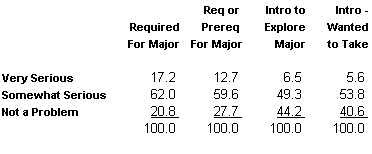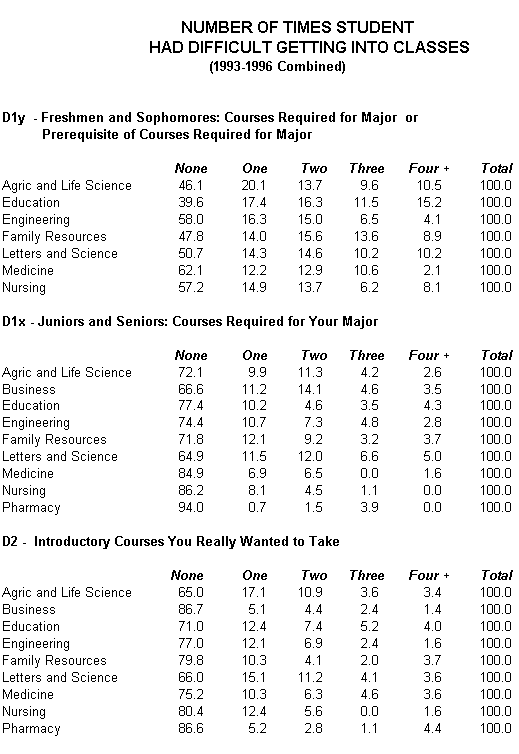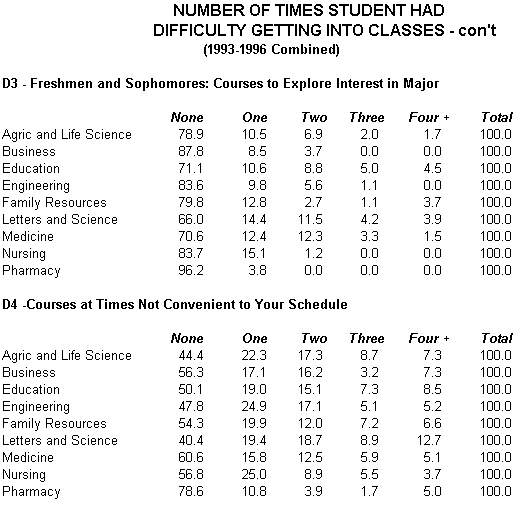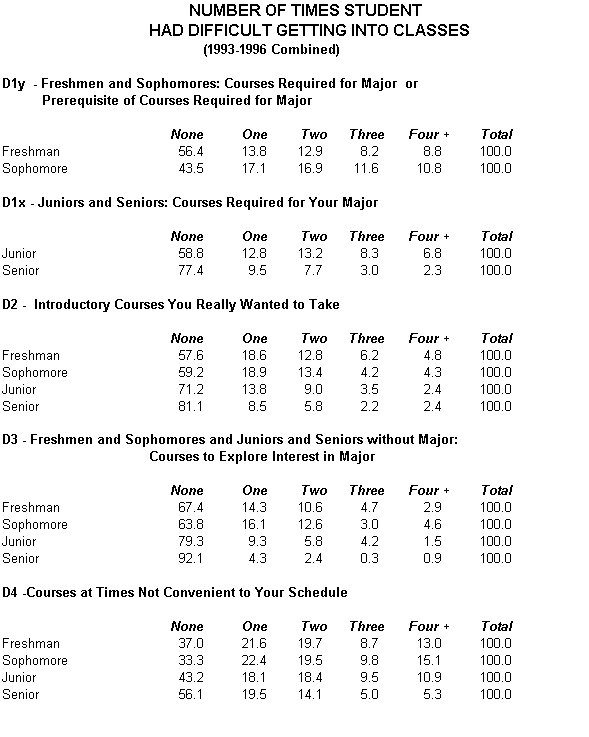

Go to Beginning of This Report - Part 1
Go to Report
on 1997 Student Survey
Advising
Frequency
of Seeing Advisor
Where
Did Students See Advisors
What
Did Students Discuss with Advisors
Group Advising
Difficulty
Seeing an Advisor
Advising
at Time of Transfer to UW-Madison
Financial Aids/Bursar's
Office
Use of E-Mail
Study Abroad
Involvement in Faculty
Research
Volunteer Community Service
Difficulty Getting
into Classes
Each survey has included modules of questions on topics of special interest. This year's topical modules dealt with advising, financial aids and bursar's office, study abroad, involvement in faculty research, and involvement in volunteer activities. In addition, the series of questions on difficulty getting into classes was expanded.
As in previous years two general advising questions were included in the core of the survey:
>E22<
(HOW DO YOU RATE) the academic advising that you received?
(Would you rate this as excellent, very good, good, fair, or poor)
Juniors and seniors were also asked:
>E11< (HOW
DO YOU RATE) advising on career preparation and planning?
(Would you rate this as excellent, very good, good, fair, or poor)
Also included in the core survey are questions about frequency of contact
with advisors.
>J1<
Next we have questions about academic advising. Since the fall
semester began, how many times, if any, did you meet with
an
academic advisor?
THOSE REPORTING SEEING AN ADVISOR MORE THAN ONCE WERE
ASKED:
>J1w<
Did you meet with the same academic advisor each time,
or did you meet with more than one advisor during this
academic year?
THOSE REPORTING MORE THAN ONE ADVISOR ASKED:
>J1y< How
did it happen that you met with different advisors
during this academic year?
THOSE STUDENTS WHO HAD NOT SEEN AN ADVISOR WERE ASKED:
>J1a< If
you needed advice on course selection, requirements, or
other academic issues, where would you go to see an advisor?
In both 1995 and 1996 the survey included a series of questions to find out where students received advising services This permits a better understanding of what exactly is being evaluated in the questions that follow.
>Ad50<
At the UW-Madison students may receive academic advising from many
different sources. Please tell me from which of the following
places
you have received academic advising. This academic year have you
received any academic advising from the Cross-College Advising
Service in Ingraham?
>Ad35< This
academic year did you receive any academic advising from a
faculty member?
IF YES,
>Ad40< Was this a faculty member
in your major department
or in another department?
(A "both" response was permitted.)
IF IN ANOTHER DEPARTMENT:
>Ad41< What department was it?
>Ad42< (This
academic year) have you received academic advising from
an advisor in a departmental office?
IF YES,
>Ad43< Was this an advisor
in your major department
or in another department?
(A "both" response was permitted.)
IF IN ANOTHER DEPARTMENT:
>Ad44< What other department was it?
>Ad45<
This academic year did you receive academic advising from an
advisor in a college or dean's office?
IF YES,
>Ad46< Which College was that?
>Ad55< This
academic year did you receive any academic advising from an
advisor in the Athletic Department?
>Ad60<
This academic year did you receive any academic advising from
an academic advisor in a minority student program or other
academic
support program?
IF YES:
>Ad61< Where was that?
>Ad65< This
academic year did you receive academic advising from
anywhere else?
IF YES:
>Ad70< Where was that?
Then there was series of questions asked for assessments of various aspects of advising, and about difficulties seeing advisors. These questions were the same as those used in previous years. (The distributions of responses to these items were presented earlier.
>J5< The
following questions are about the quality of advising you
have received this academic year. How would you rate the
quality of
advising about course selection that you have received
this
academic year? Would you rate it as excellent, very good,
good, fair, ]
or poor?
>J5a< (How would
you rate) the advising regarding requirements of your major
or majors you are considering?
IF FAIR OR POOR:
>J5a1< What do you think most
needs improvement?
>J5b< (How
would you rate) the academic advising about breadth requirements
that you have received this academic year?
IF FAIR OR POOR:
>J5b1< What do you think most needs improvement?
>J5c<
(How would you rate) the quality of academic advising about career
opportunities that you have received this academic year?
IF FAIR OR POOR:
>J5c1< What do you think most
needs improvement?
>J6< (How
would you rate) the amount of time your advisor was able to spend
with you?
>J8< How
would you rate the advisors' knowledge of rules, requirements, and
academic programs?
>J9< (How
would you rate) the advisors' attitude toward you?
IF FAIR OR POOR:
>J9a< What do you think most
needs improvement?
FOR THOSE WHO HAVE SEEN AN ADVISOR:
>J7< During
the current academic year, have you had serious difficulty
in attempting to schedule a time to meet with an academic
advisor?
FOR THOSE WHO HAVE NOT SEEN AN ADVISOR:
>J7z< During
the current academic year, have you tried to schedule
a time to meet with an academic advisor, but were unable
to arrange a meeting?
IF YES:
>J7a< Can you tell me about that? When were
you unable to meet with
an advisor? What happened?
Later in the interview there were questions regarding what students
had discussed with academic advisors this year.
>av1<
I am going to read a list of things that students sometimes discuss with
academic
advisors. Tell me whether or not you have discussed each
of them with an academic
advisor since the beginning of this academic year.
Have you discussed the requirements of (a/your) major?
>av2< Other degree requirements?
>av3< Academic difficulties that you were having?
>av6< Have
you discussed selection of courses with an academic advisor
since the beginning of this academic year?
>av8< Career plans or possibilities?
>av9a< The connection between academic programs and possible careers?
>av9< Honors opportunities?
>av10< Graduate or professional schools?
>av11< Problems you were having with specific courses or instructors?
>av5< Personal problems you were having?
And finally students who had transferred to the UW-Madison were asked:
>trs1<
Thinking back to the time that you transferred to the UW-Madison,
how satisfied were you with the assistance you received
in planning
your academic program? Were you very satisfied, somewhat
satisfied,
somewhat dissatisfied, or very dissatisfied?
Seventy-four percent of students reported having met with an academic advisor at least once since the beginning of the current academic year. (Note that the survey was conducted during the second semester so that the number of advisor contacts reported does not cover the whole academic year.) Half of the students reported meeting with an advisor more than once and 10 percent met four or more times. The average number of advisor contacts is 1.80; the average number for students who have seen an advisor is 2.42.
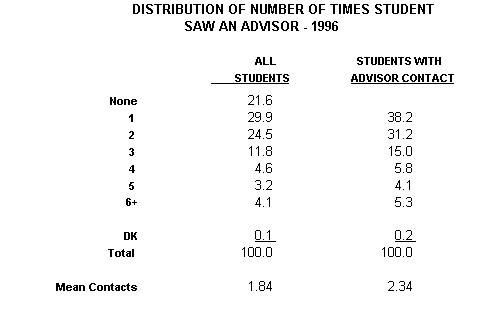
The proportion of students not seeing an advisor at all decreased from 30 percent to 22 percent over the past four years. Among students with advisor contact, there has been little change since 1994 in the frequency of seeing advisors.
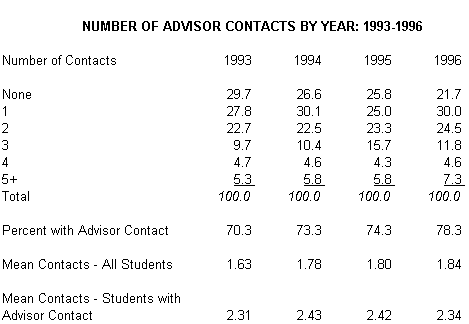
How does advisor contact vary by characteristics of students? For these comparisons we combine the 1995 and 1996 samples in order to increase the statistical reliability of comparisons.
Freshmen have the lowest proportion with advisor contact (74 percent). There is not much difference by year among upperclassmen, particularly when students who had already graduated are removed from the seniors. Among students with advisor contact, the number of contacts tends to increase by year in school (2.24 contacts for freshmen; 2.52 for seniors).
Advising is organized differently in the various colleges, and there is considerable variation in the amount of advisor contact by college. The School of Business has the lowest proportion of students with advisor contact (64 percent) and the lowest number of contacts per student with contact (1.68). Students in CALS and FRCS have high proportions with advisor contact, and a higher than average number of contacts per student with contact (2.86 for CALS and 2.68 for FRCS).
There is variation in advisor contact by characteristics of students. Women are more likely than men to see an advisor (80 versus 72 percent. And women who see an advisor have more contacts (2.5 versus 2.3).
Black students are more likely than majority white students to see advisors (82 versus 76 percent), and those who have seen an advisor have more contacts (4.3 versus 2.3 contacts). Other minority groups have proportions with advisor contact that are very similar to that of majority whites. Hispanic students who have seen advisors have more contacts than majority whites, but not as many as black students.
Both the proportion of students with advisor contact and the number of contacts per student with contact tend to decrease with academic ability measured by the ACT/SAT score. The pattern by GPA is less orderly. The number of contacts decreases with increasing GPA except that the highest GPA group has the most contacts.
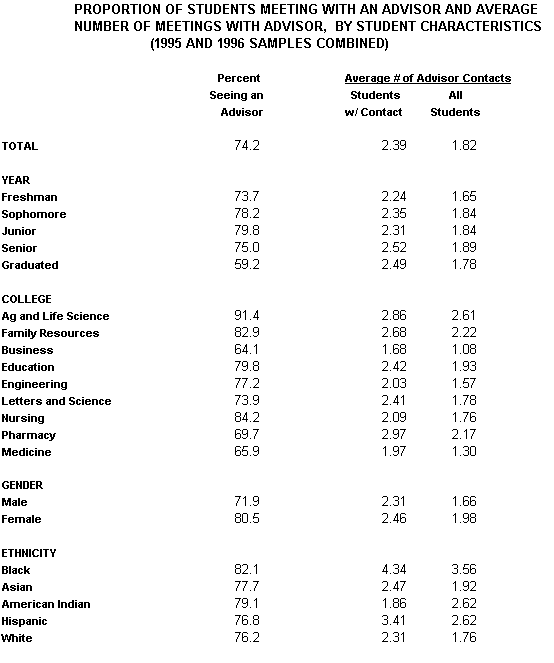
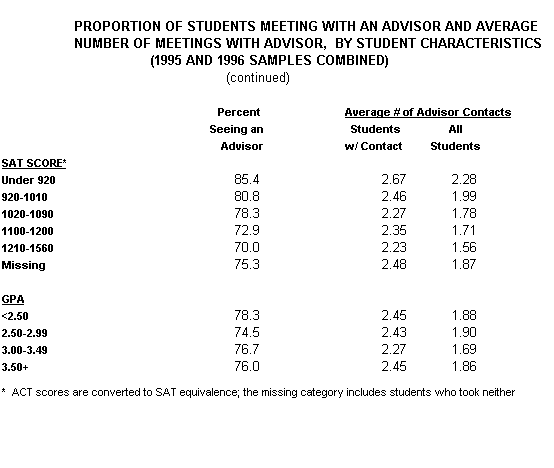
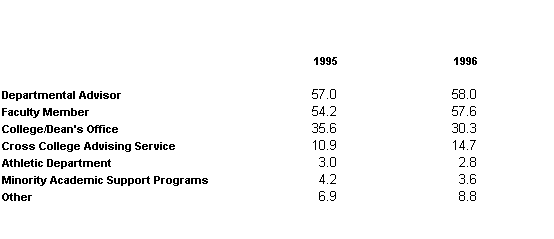
The proportions of minority and majority white students using the major advising sources are quite similar. A disproportionate number of black students receive advising from the Athletic Department advisors. And, not surprisingly, a large proportion of minority students (with the exception of Asian students) receive advising services from minority program staff members.
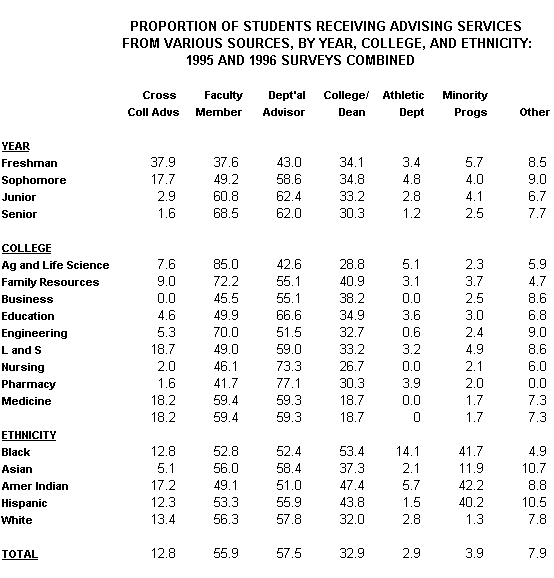
sheeet1.
The table below shows the proportion of students who discussed each topic with an advisor this year. The upper panel of the table includes all students in the base of the percentages. It tells us what percent of all students, including those who had no advisor contact, discussed each subject with an advisor. The percentages in the lower panel of the table are based on only students with advisor contact - - what percent of students who met with an advisor during the academic year discussed each topic with an advisor?
The topics are listed in descending order from the most to the least frequently discussed.
Not surprisingly the most frequently discussed topics are major requirements, course selection, and other degree requirements. These are issues that are relevant to all students. The least frequently discussed topics include personal problems, honors opportunities, problems the student was having with specific courses or instructors, and academic difficulties.
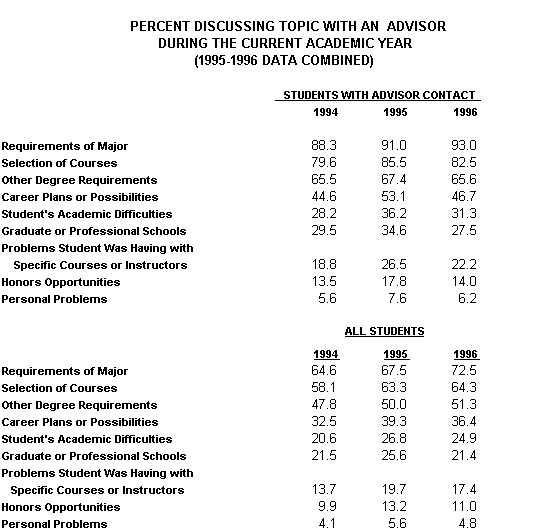
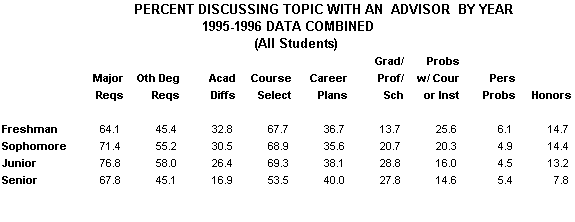
A question regarding "group advising" was added in the 1996 survey:
>GP1<
Sometimes there are sessions where advisors meet with groups of students
to discuss
program requirements, registration procedures, and other
issues of interest to
students. Have you participated in any of these group
advising sessions this
academic year?
IF YES:
>GP1a< Please describe the most recent session
in which you participated.
(INTERVIEWER: FIND OUT THE PURP OSE OF THE SESSION: WHAT
SORTS OF THINGS WERE DISCUSSED?
>GP2<
How would you assess your group advising experience this year?
Was it excellent, very good, good, fair, or poor?
IF FAIR OR POOR:
>GP2a< What do you think most needs improvement?
Sixteen percent of all students reported having participated in a group advising session this year. Of them, 54 percent assessed their experience with group advising as excellent or very good, and 13 percent assessed it as fair or poor.
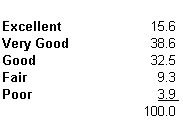
Students were asked if they had had difficulty scheduling an appointment with an advisor. Those who had advisor contact were asked if they had had difficulty scheduling a time to meet; and those who had no advisor contact were asked if they had tried unsuccessfully to schedule a time to meet. In 1996 about one-seventh of those who had seen an advisor said they had difficulty and one-tenth of those who had not seen an advisor had tried to. These proportions have been quite stable over the four survey years. The table on the next page shows differentials by College, year in school, gender, ethnicity, and grade point average using data from the combined 1995 and 1996 samples.
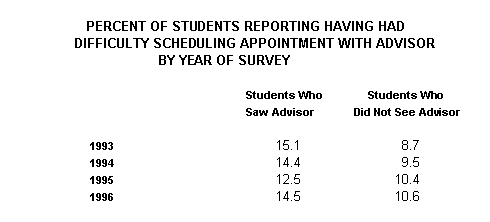
Students who transferred to the UW-Madison from another University were asked to assess advising that they received at the time of transfer. Since transferring is relatively rare, we combine data from the 1995 and 1996 surveys. (Note that the question was asked of all students who transferred - not just those transferring in the past year. Some of the experience being reported occurred several years prior to the survey.)
Most students are quite satisfied with the advising that they received at the time that they transferred to the UW-Madison, although 28 percent report being dissatisfied.
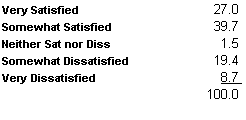
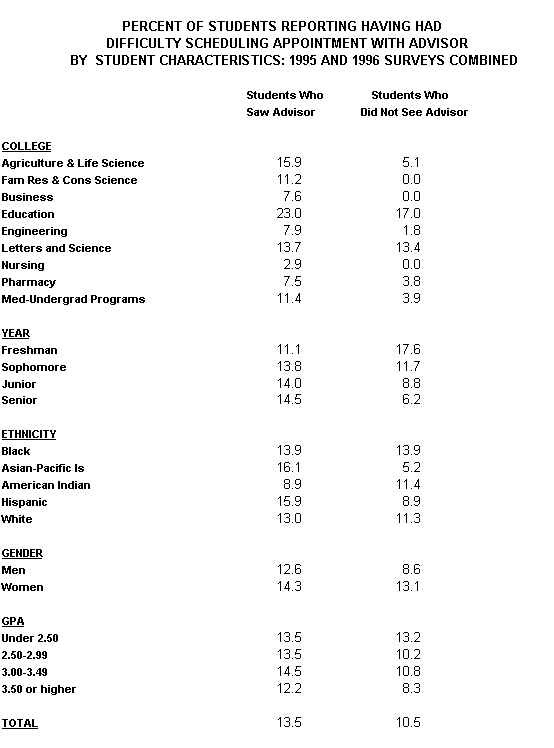
In each survey since 1993 students were asked to assess overall financial aid services. In 1995, questions on specific aspects of financial aid services were added. This year additional questions were added to assess tuition payment at the bursars's office and financial aid check dispersement. The full set of 1996 questions were:
>Bu01<
The Bursar's Office, which is in the Peterson Building, handles
tuition payment and financial aid check
disbursement.
How would you evaluate the process of tuition payment? Would
you say it is excellent, very good,
good, fair, or poor?
THOSE ANSWERING FAIR OR POOR:
>Bu1a< What do you think most needs improvement?
STUDENTS RECEIVING FINANCIAL AIDS:
>Bu02<
How would you evaluate the process of financial aid check
disbursement? (Would you say it is
excellent, very good,
good, fair, or poor?)
THOSE ANSWERING FAIR OR POOR:
>Bu2a< What
do you think most needs improvement?
STUDENTS RECEIVING FINANCIAL AIDS
>Fi02<
The next questions are about your experience with the Office of
Student Financial Services which administers
financial aid on
the UW-Madison campus.
How would you evaluate the usefulness of printed materials
regarding financial aid that you have
seen? Would you say it
is excellent, very good, good, fair, or poor?
>Fi03<
(How would you evaluate) the assistance you have received in
preparing financial aid forms? (Would you say it is excellent,
very good, good, fair, or poor?)
>Fi05<
(How would you evaluate) the speed in receiving your award
letter? (Would you say it is excellent, very good, good,
fair, or poor?)
>Fi07<
(How would you evaluate) your contact with Student Financial
Services over the phone? (Would you
say it is excellent,
very good, good, fair, or poor?)
>Fi09<
(How would you evaluate) the assistance you receive from
financial aid counselors? (Would you
say it is excellent,
very good, good, fair, or poor?)
About half of the students assessed the tuition payment process as excellent or very good and 18 percent assessed it as only fair or poor. Among students receiving financial aids, slightly over one-third assessed the check dispersement process as excellent or very good and one third assessed it as fair or poor.
As described above, among students with contact with financial aids services, nearly half (48 percent) provide an overall assessment of these services as excellent or very good. The assessments of the individual aspects of financial aid services are not as favorable. The proportions responding "excellent" or very good for these items were:
Help with Forms 27.7
Speed of Award Letter 26.6
Phone contact 31.8
Counsellors 30.2
We looked at whether there was variation in these assessments by year in school or by ethnicity and there was not.
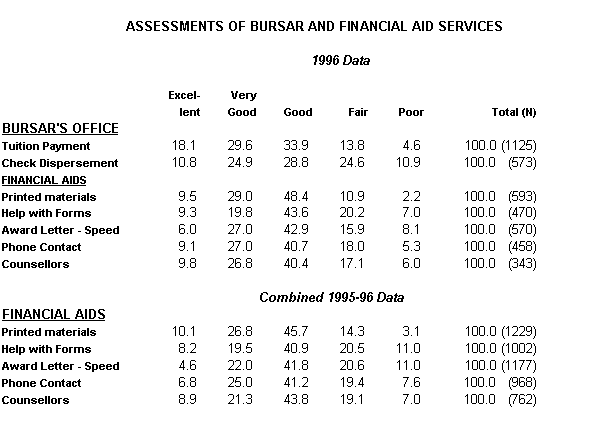
Cm01 Do you have a UW-Madison e-mail account?
IF YES,
Cm05 How often do you check to see if you have
any e-mail
messages? Is it once a day or more, every few days,
about once a week, less than once a week or never?
Cm10 How often, if ever, do you use e-mail to communicate
with instructors or TA's in courses you are taking?
Cm15 How often, if ever, do you use e-mail to communicate
with other UW-Madison students?
Cm20 How often, if ever, do you use e-mail to communicate
with family members or friends off the Madison campus?
Cm25 How often, if ever, do you use e-mail to communicate
with UW-Madison student service or administrative
offices, such as financial aids, registrar, or dean's
or departmental staff members?
Cm27 How often, if ever, do you use e-mail to communicate
with a UW-Madison academic advisor?
There Was a Continued Increase in the Proportion of Students with E-mail Accounts
In the 1996 survey 93.5 percent of students reported having a UW-Madison e-mail account. This was an increase from 81 percent in 1995 and 55 percent in 1994.
Students Check E-Mail More Frequently
The proportion of students reporting that they check e-mail daily rose from 35 percent to 48 percent over the past year. The proportion checking e-mail once a week or less frequently declined from 20 to 12 percent.
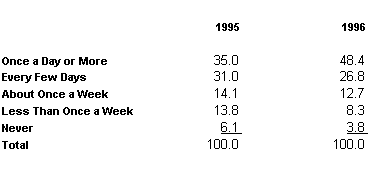
Note that the base for these percentages, and those in the tables that follow, includes only students with e-mail accounts. So the proportion of all students who check e-mail daily increased even more rapidly since the fraction of all students with e-mail accounts increased by about ten percentages points.
Students Have More Frequent E-mail Contact with Instructors
Forty-four percent of students with e-mail accounts report communicating with instructors by e-mail one or more times a week. This compares with 32 percent a year earlier. Only 15 percent of students with e-mail accounts report never communicating with instructors by e-mail.
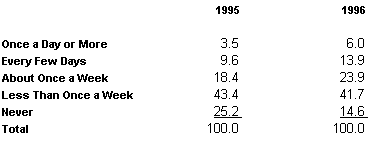
There was a Small Increase in the Frequency of E-Mail Communication Among Students
Sixty-eight percent of students with e-mail accounts report having e-mail contact with other students once a week or more. Fourteen percent report never having e-mail contact with other students. E-mail contact among students increased slightly in the past year.

Off-Campus E-Mail Communication Increased Greatly
Two-thirds of students with e-mail accounts report communicating with off-campus friends and family members once a week or more. This is an increase of about 12 percentage points in the past year.
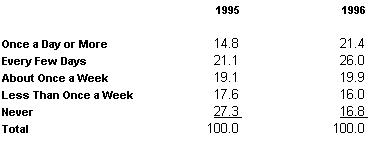
E-Mail Communication with UW-Madison Administrative Offices Increased, but Is Still Relatively Rare
About one-third of students with e-mail accounts reported that they communicated with UW-Madison administrative offices by e-mail. This is up from 18 percent a year ago. Very few students reported that they did this more than occasionally.

E-mail Communication with Advisors Increased, but is Still Quite Rare.
About one student in four reported having had e-mail communication with and academic advisor. This proportion increased by about ten percentage points in the past year.
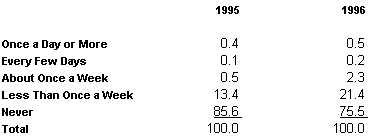
There is not much variation in prevalence of e-mail by year in school - - the fraction is highest for sophomores (96%) and lowest for seniors (89%). There is variation in the prevalence of e-mail accounts by college, but most notable is that the overwhelming majority of students in all colleges have and use e-mail. Between 1995 and 1996 there was a striking increase in e-mail use in all colleges and all years in school, with the groups of students with low e-mail use a year ago catching up with the groups with higher e-mail use.
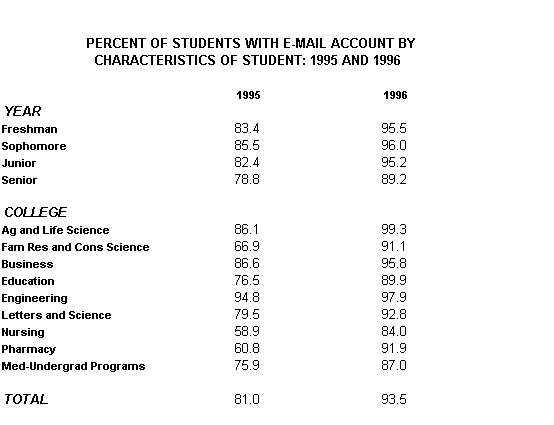
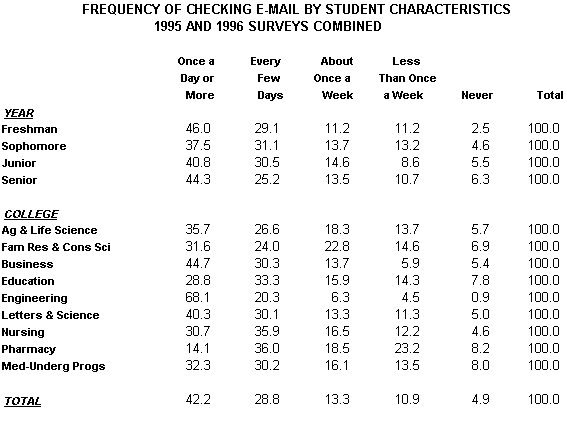
As noted above students are increasingly using e-mail as a means of communication with instructors, other UW-Madison students, persons outside the University, advisors and administrative offices. In the tables below we show frequency of different types of e-mail use by year in school and college.
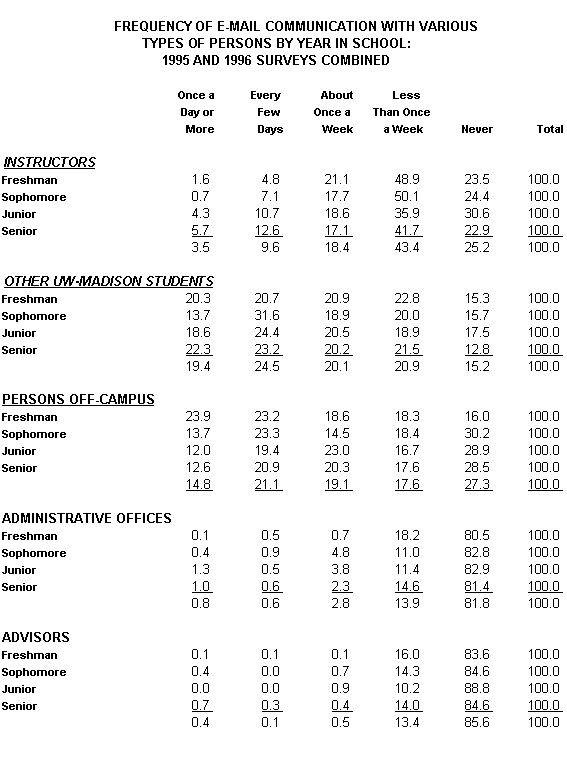
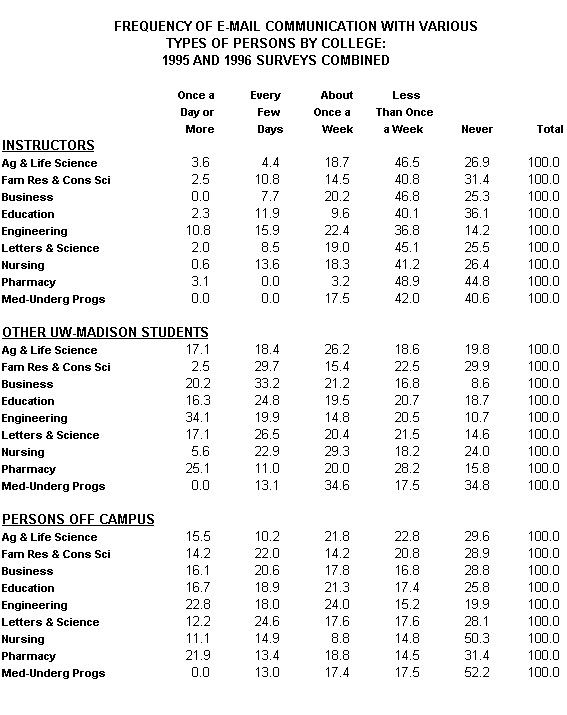
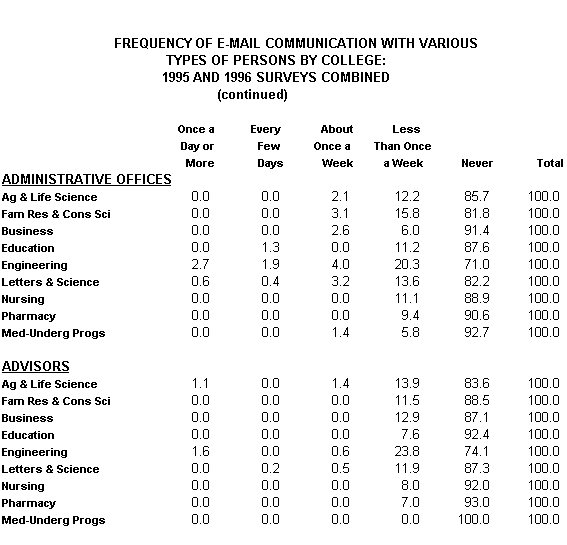
Sample students were asked about their experience with and interest in spending time abroad as a part of their undergraduate experience. These questions were not asked of non-US citizens.
>St1< Have you studied abroad at any time since you first started college?
IF YES:
>St2a< Did you study abroad for an entire academic
year, a
semester, a summer, or what?
>St2b< What year was that?
>St2c< Where did you study abroad?
>St2d< Did you study abroad in a UW-Madison
program or in a program
administered by some other institution?
>St2l< How much would you say that studying
abroad delayed your
graduation? Would you say it was not at all, one semester,
two semesters, or more than two semesters?
>St2e< How would you rate your overall study
abroad experience?
Would you rate it excellent, very good, good, fair, or poor?
Students who had not studied abroad (and who had not already graduated) were asked a series of questions about their interest in studying abroad.
>St2g<
How much interest do you have in studying abroad as a part
of your college experience? Would you say you have no
interest
at all, some interest, or a great deal of interest?
IF ANY INTEREST:
>St2p< How likely do you think it is that you
will actually study
abroad before you complete your undergraduate degree?
Is
it very likely, somewhat likely, or unlikely?
IF ANY RESPONSE EXCEPT "UNLIKELY":
>St2i< (If you were to study abroad), where
would you like to study?
>St2j< Do you expect to study abroad on a UW-Madison program?
STUDENTS WHO HAVE OR WILL STILL STUDY ABROAD:
>St3a<
Many factors are involved when a student makes the decision
to study abroad. How important (is/was)
enhancing your major in your
decision to study abroad? (Is/Was it very important,
somewhat important, or
not at all important?
>St3b<
How important (is/was) improving your preparation for your career
in your decision to study abroad? (Is/Was) it very important,
somewhat important, or not at all important?
>St3c<
How important (is/was) a desire to experience different cultures
(in your decision to study abroad? (Is/Was it very important,
somewhat important, or not at all important?)
>St3d< How
important (is/was) a desire to become more proficient in
another language (in your decision to study abroad? (Is/Was
it very
important, somewhat important, or not at all important?)
STUDENTS WHO DID NOT AND WILL NOT STUDY ABROAD
>St4a< Many
factors contribute to a student's decision NOT to study abroad.
How important (is/was) cost in your decision not to study
abroad? (Was it very important, somewhat important, or not at all
important?)
>St4b< How important
(is/was) not wanting to delay your graduation
(in your decision not to study abroad? Was it very important,
somewhat important, or not at all important?)
>St4c< How important
was the irrelevance to your major and career goals
(as a factor in your decision not to study abroad? Was
it very
important, somewhat important, or not at all important?)
>St4d< How important are
language limitations (as a factor in your decision
not to study abroad? Was it very important, somewhat important,
or
not at all important?)
>St4e< How important is
reluctance to live in another culture
(as a factor in your decision not to study abroad? Was it very
important, somewhat important, or not at all important?)
>St4h< How important
is family or personal reasons (as a factor
in your decision not to study abroad? Was it very important,
somewhat important, or not at all important?)
>St4f< Were
there any other factors that contributed to your decision not to
study abroad?
IF YES,
>St4g< (What was that?)
Five percent of students reported that they had spent time studying abroad. Among seniors, 12.2 percent had studied abroad. (It should be noted that there is a small downward bias in estimates of prevalence of study abroad experience, since most students currently abroad are not included in the sample.) Of the students who reported spending time in an academic program abroad:
54 percent spent one semester
22 percent spent a summer
8 percent spent some other period
Students who had studied abroad were asked how much they think their
graduation will be delayed because of having spent time abroad. Three-fifths
of students reported that they thought it would not be delayed at all.
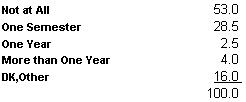
Students who had not spent time abroad, were asked about their interest in doing so. About three-fifths of students said that they were interested. One quarter said that they had a great deal of interest.

Those with some or a great deal of interest were asked how likely they thought they were to actually study abroad.

Students who had studied abroad or who reported that it was very or somewhat likely that they would study abroad were asked what they thought the benefits were. Almost ninety percent said experiencing a different culture was very important. Two-fifths cited improving language skills and one-third enhancing their major and career preparation as very important.

Students who were not interested or who thought it was unlikely that they would study abroad were asked were asked about reasons for not being interested. Delay of graduation was most frequently cited as very important. Cost, personal reasons, and lack of career relevance were also mentioned as very important by about one-third of respondents who did not expect to study abroad.
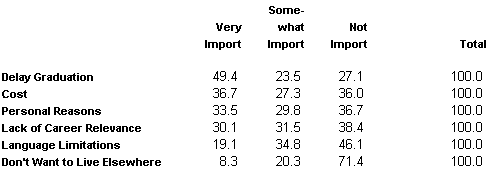
Two series of questions relating to out-of-the-classroom learning experiences were added to the 1996 student survey. One dealt with student involvement in faculty research; the other with volunteering.
>V01<
Students participate in a number of educational activities besides
attending classes. In the current academic
year, have you participated in
research with a faculty member? This would
include a paid job on a research
project, as well as volunteer or unpaid work involving
a faculty
member's research.
IF YES,
>V02< Was that paid or unpaid?
>V04< Did you receive academic credit for this work?
>V06< In the current academic year, about how
many hours per week,
on average, did you spend on this research?
>V05x< Please describe this research project.
>V07< How closely related was your research experience
to your
academic program? Was it very closely related, somewhat
related, or not at all related?
>V05< How satisfied are you with your research experience?
Are you
very satisfied, somewhat satisfied, somewhat dissatisfied, or
very dissatisfied?
One student in seven reported that they had been involved in faculty research during the current academic year. The percentage varied by year in school from 7 percent of freshmen to 18 percent of seniors. Most of the difference is between freshmen and sophomores.

There is little difference between men and women.
Black students are somewhat more likely than majority white students to be involved in faculty research, although the difference is not statistically significant.

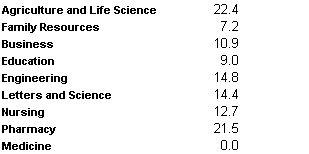
About three-fifths of the students reported that they are not paid for the work that they do.


Not surprisingly, students receiving academic credit for their work are less likely to be paid than those not receiving academic credit. Two-fifths of students who did not receive academic credit were not paid either.

The mean number of hours per week that students spent working on faculty research was 8.9. The number of hours per week varied a great deal. About 30 percent reported working four or fewer hours per week. Another quarter worked 5-9 hours per week and nearly 40 percent reported working 10 or more hours per week.

About one-third of students doing paid work on faculty research spend fifteen or more hours per week; and among those doing unpaid work over one-fifth spend fifteen or more hour per week.

About two-fifths of students who have been involved in faculty research report that it was closely related to their academic program, and another 46 percent say that it was somewhat related.


Assessments of the experience with faculty research tend to be very positive, with nearly three-fifths of students reporting that they were "very satisfied" with the experience. Only 5 percent were dissatisfied.

Students working in a paid capacity report slightly higher satisfaction with the experience than those doing unpaid work. Still only 7 percent of the latter group report being dissatisfied.

A parallel series of questions on volunteer community service was also included:
>V20<
In the current academic year, have you participated in any volunteer
community service projects?
IF YES,
>V25< Did you receive academic credit for this work?
>V27< In the current academic year, about how
many hours per week
did you volunteer?
>V26x< Please describe this volunteer community service project.
>V28< How closely related was your volunteer community
service
experience to your academic program? Was it very closely
related, somewhat related, or not at all related?
>V29< How did you get information about this volunteer
community
service project?
>V26< How satisfied are you with your volunteer community
service
experience? Are you very satisfied, somewhat satisfied,
somewhat dissatisfied, or very dissatisfied?
Twenty-seven percent of students reported that they had done some volunteer community service this academic year. The fraction is somewhat higher for seniors than for students in the lower classes.


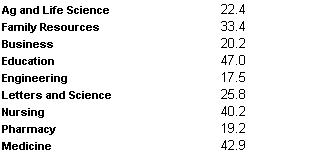
Differences by ethnicity are not large - - Black and Hispanic students seem to be slightly more likely than majority white students to engage in volunteer community service. Asian students are least likely.


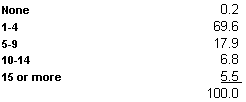
Half of the students who volunteered reported that it was not at all related to their academic programs, and about one-quarter said that it was closely related.

Assessments of the experience with volunteer community service tend to be very positive. Nearly three-quarters reported being very satisfied.

A somewhat different set of questions was asked of students at different levels.
ASKED OF JUNIORS AND SENIORS
D1x Sometimes
students have difficulty getting into courses that they
wish to take. Sometimes space is available in a course,
but not at
convenient times, and sometimes students are unable to
get into a
course at all because there are no spaces available. First
we want
to ask about your experience of not being able to get
into courses
at all.
Since the beginning of the current academic year, how many times,
if any, have you been unable to get into upper level courses
required for your major?
IF ANY,
How much of a problem was this for you: Was it a very serious
problem, somewhat of a problem, or not a problem at all?
IF IT WAS A PROBLEM:
In what way was not getting into major courses a problem for you?
IF IT WAS NOT A PROBLEM:
Why was this not a problem for you?
Freshmen and sophomores were asked the same question, but with an adaptation of wording. Instead of limiting the question to course "required for your major", the wording for freshmen and sophomores referred to "course required for your major, or courses which are prerequisites for courses required for a major".
ASKED OF ALL STUDENTS:
D2 (SINCE THE BEGINNING
OF THE CURRENT ACADEMIC YEAR, HOW MANY
TIMES, IF ANY, HAVE YOU) been unable to get into introductory
courses that you really wanted to take?
IF ANY,
How much of a problem was this for you: Was it a very serious
problem, somewhat of a problem, or not a problem at all?
IF IT WAS A PROBLEM:
In what way was not getting into major courses a problem for you?
IF IT WAS NOT A PROBLEM:
Why was this not a problem for you?
ASKED OF FRESHMEN AND SOPHOMORES:
D3 (SINCE THE BEGINNING
OF THE CURRENT ACADEMIC YEAR, HOW
MANY TIMES, IF ANY, HAVE YOU) been unable to get into courses you
wanted to take in order to explore interest in a possible major?
IF ANY,
How much of a problem was this for you: Was it a very serious
problem, somewhat of a problem, or not a problem at all?
IF IT WAS A PROBLEM:
In what way was not getting into major courses a problem for you?
IF IT WAS NOT A PROBLEM:
Why was this not a problem for you?
ASKED OF ALL STUDENTS:
D4 Since the beginning
of the current academic year how many times, if
any, have you not been able take courses that you wanted to take
because there was not space available at times that were convenient
to
your schedule?
Thirty-three percent of juniors and seniors reported having been unable to get into a course required for their major. Twenty-four percent reported that this happened two or more times. About half of the Freshmen and Sophomores said that they were unable to get into a course that was required for or was a prerequisite for a major - about a third reported that this happened two or more times. One-fifth of Freshmen and Sophomores said that they were unable to get into an introductory course that they wanted to take to explore an interest in a possible major, and about a quarter of all students said that they were unable to get into an introductory course "that they really wanted to take." Slightly over half of students said that they were unable to get into classes at times that were convenient to their schedules.
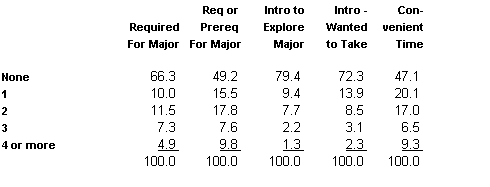
TREND IN DIFFICULTY GETTING INTO COURSES
These questions were included in identical form in each of the four surveys. The table below shows the percent reporting that they did NOT have difficulty getting into any courses. The proportions are quite similar from year to year. There may have been a slight decline in difficulty getting into courses between 1995 and 1996, but this is true only for courses that are NOT required for or prerequisites for courses required for their major.
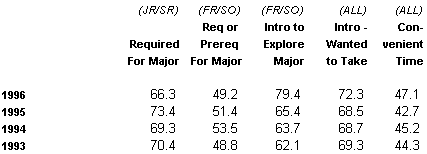
The tables on the following pages show differentials by College and by year in school. Data from all four surveys are combined for these comparisons.
HOW SERIOUS A PROBLEM WAS IT?
Relatively few students reported that the difficulty they had in enrolling in classes was a very serious problem for them. About one-in-four or one-in-five of the students who could not get into a course required for a major or as a prerequisite for a major said that it was not a problem for them. About three-fifths said that it was somewhat serious and about one-in-six to one-in-eight said that it was a very serious problem. About 40 percent of students who could not get into classes to explore a possible interest in a major or that they wanted to take said that it was no problem, and only about 6 percent said that it was a very serious problem.
